How to Choose the Right Geyser to Make Best Use Of Power Efficiency in your house
Picking an energy-efficient geyser is not as simple as it appears, needing mindful analysis of different elements. From understanding the various kinds of geysers, to assessing their energy efficiency rankings and considering positioning technique, each choice plays a vital duty in maximizing effectiveness. Balancing the preliminary financial investment with long-lasting financial savings is additionally vital. Let's begin on this trip to find just how to make the most educated selection for a geyser that will certainly reduce your energy costs while guaranteeing optimum performance.

Understanding the Various Types of Geyser
While there are numerous types of hot springs readily available on the market, recognizing the differences in between them is essential for power efficiency (geyser sizes). The very first kind, storage hot springs, are the most typical and store hot water in a container for use when needed. They are readily available in various abilities and are typically energy-efficient, yet they can shed heat when not in usage
The 2nd kind is the tankless geyser, which heats up water on need, leading to much less power waste yet calling for a greater preliminary power draw. Solar geysers use solar energy to heat the water, making them the most energy-efficient but also the most expensive.
Assessing Your Household's Warm water Demands
Before diving right into the purchase of a geyser, it is critical to assess the hot water demands of your family. This evaluation should consider countless factors consisting of the variety of home participants, regularity of warm water use, and the variety of warm water electrical outlets in the home (geyser sizes). A little family with infrequent warm water usage could need a smaller sized, much less effective geyser contrasted to a larger family with several everyday warm water requirements
The sort of home appliances that require warm water also play a substantial role. Dishwashing machines and washing makers, for instance, might require more warm water than a basic shower or kitchen area sink. Specific activities such as showering or cleaning likewise influence the frequency and quantity of warm water needed.
Reviewing Energy Effectiveness Rankings of Geyser
Having actually analyzed the warm water needs of your family, it is very important to turn your interest to the power performance scores of hot springs. These rankings, typically provided as Power Variable (EF), indicate a geyser's general energy effectiveness based upon the quantity of warm water produced per unit of fuel taken in over a regular day. The greater the EF, the more efficient the water heating unit.

Factors To Consider in Geyser Size and Positioning
Beyond power performance rankings, the dimension and positioning of your geyser are vital aspects to take into consideration. The dimension of the geyser need to straighten with your family's warm water requirements. A small geyser may use much less energy but might not give adequate warm water for several uses at the very same time, whereas a larger system can satisfy greater need yet may consume more power.
Positioning likewise influences energy effectiveness. Geysers should be installed near points of use to minimize warmth loss during water transport. A centrally located geyser can service numerous locations successfully. Furthermore, considering thermal insulation, a hot spring situated in a warmer location sheds less warmth and as a result utilizes much less energy to maintain the water temperature level.
Expense Evaluation: Balancing First Investment and Long-Term Financial Savings
While size and positioning certainly play substantial functions in a hot spring's energy effectiveness, one must not ignore the economic element. When thinking about the initial investment, the rate of energy-efficient geysers can be greater than standard designs. Nonetheless, the enhanced in advance price can be countered by lasting energy financial savings, making it a worthwhile investment in the future.
Assessing long-term savings needs an understanding of the geyser's power ranking. An appliance with a higher score will take in much less power, converting to reduced utility click to read expenses gradually. Government rewards and refunds for energy-efficient home appliances can likewise assist recover preliminary expenses.
Finally, maintenance and lifespan must be factored in. Energy-efficient hot springs usually have longer lifespans and reduced maintenance prices, contributing to general financial savings. As a result, when stabilizing initial financial investment and lasting financial savings, one need to think about not only the acquisition cost yet additionally power intake, government rewards, and upkeep costs.

Verdict
These include understanding the home types of geysers, evaluating your household's hot water needs, assessing energy effectiveness ratings, and calculating expense advantages. The right geyser dimension, placement, and insulation can considerably minimize energy bills and environmental effect.